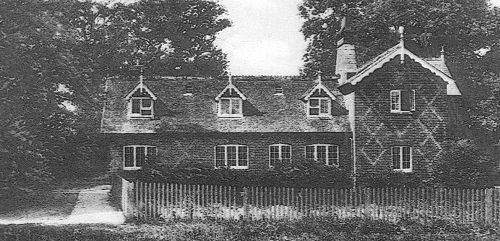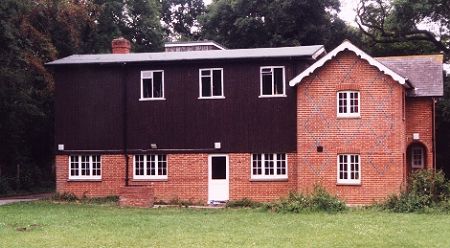- Wanborough School
- (1867 to 1946)
Both that first Wanborough School and its 1871 replacement were at Pond
Hill Wanborough, located off the present unmade track leading from West
Flexford to East Flexford being a continuation of Flexford Road at Flexford
Lane.
By the 1850s, the number and effectiveness of National Schools throughout
the country were sufficient to arouse the interest of the truly rural pastor
and gentry to the real and urgent need to establish a school within their
own parish. The National Society, in 1816, realising the difficulties confronting
the rural parishes to find funds with which to build a school, had suggested
that a good barn could be converted easily and economically into a building
suitable for a school, reporting that "A barn furnishes no bad model
and a good one may be easily converted into a school". Did this imaginative
suggestion appeal to Mrs Mangles of Wanborough Manor, who might well have
founded that first school for the families, retainers and workers of the
Wanborough Manor Estate?
The 1871 Ordnance Survey map shows a building labelled "school
for boys and girls", the outline of which corresponds to the present
"Wildfield" dwelling. Inspection of the dwelling indicates solid
chalk (Clunch) construction and in 1920, when the dwelling was extended,
further evidence was found of a previous steep stairwell or ladder giving
access to an upper storey. Piercing of those upper walls evidenced again
the use of Clunch. Perhaps there is credence for the conversion of a rural
building?
Regarding that school of 1867, Miss Maria Stedman was stated as the
Mistress on the opening page of the first mandatory logbook and the Rev
Chilton is entered as Corresponding Secretary. He was Secretary until 1894
and succeeded by the Rev Raywood Firth in 1895. It is highly probable that
Miss Stedman had held the post of Mistress from when the school started,
for when she left in the September of 1868 following "the harvest
vacation" that commenced on the 9th of August, her successor, Miss
Maria Paxon, who arrived in the October to take charge of the school, did
not make an auspicious start for H M Inspector noted in his report "that
the order and discipline seemed to be not so well maintained as in former
years". Miss Paxon was, nonetheless, to dutifully serve Wanborough
School for the next 24 years, retiring in the May of 1902.
For Miss Paxon, 1871 was a very agreeable year. Mr McKibben, the new
owner of the Wanborough Manor estate visited the school in the October
and promised the children a good seat at the proposed opening of the new
school and school-house, built at his own expense in the corner of the
adjoining field. That building is now the defunct Wanborough Youth House.
In the following May, the first assistant teacher, Miss Caroline Fish,
was appointed, and in June, Miss Paxon took up residence in the schoolhouse.
The report of the Inspector in 1873 was far more encouraging, complimenting
her on her able administration of both the religious and secular teaching
of the children.
Mrs Beeney, Head teacher from 1899 to 1903, lived in the school-house
with her husband and Head teacher Mr Marriott from1905 to 1925 lived there
with his family until moving to his own house, "Holly Bank" in
Station Road, now Glaziers Lane. Mrs Stoakes, caretaker of the school,
lived there with her two daughters Irene and Bessie and later, Bessie returned
as Mrs Morgan to visit her mother in 1934 and gave birth there to her own
daughter, who attended the school as a pupil in 1945.

- Wanborough School c1930
The school consisted of one main room 35 feet by about 17 feet (heated
by a single stove), divided by a screen into two departments to segregate
the younger children from the older ones. The larger part was for the older
boys and girls with about 11 boys and 7 girls and the other for the younger
ones, of which there was a similar mix of boys and girls. The average daily
attendance was 30 pupils. Water was brought to the school by pails from
a tap sited some distance away supplied by pipe from a spring at Wanborough
Manor. On 18 January 1904 the school was declared a County Council School
and water was eventually connected to the school in March 1909.
On the 30th November 1945 the Education Committee reported that "the
number of children on the register of this school is now 11 and the Divisional
Executive recommend that steps should be taken to close the school at the
end of March 1946" In June1946 the Education Committee reported that
the school closure was completed on the 11th April. The committee was of
the opinion "that the buildings can usefully be utilised in connection
with camping facilities to be made available on the site and this matter
is under consideration by the Youth Sub-Committee". In 1948 the Education
Committee referred to the facility as "Wanborough Camp House"
and following extension works and modernisation the new facility was called
"Wanborough Youth House" subsequently closed in 2007.

- Wanborough Youth House c2000
The once striking and decorative brickwork of the fine old Victorian
building can only be fully seen on the facade of the schoolhouse. The pretty
dormer windows that permitted light into the schoolroom and gave the building
a "cottage" appearance no longer exist having been replaced with
a drab wooden cladding. Perhaps one day the building may be sold and converted
into a smart dwelling.
Peter Blakiston
|